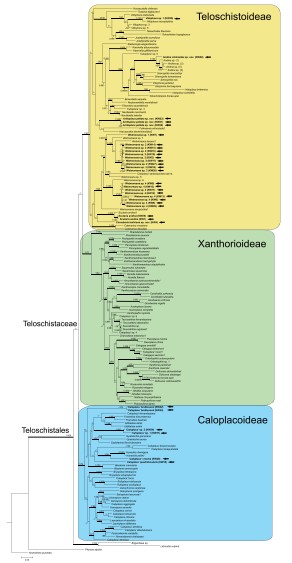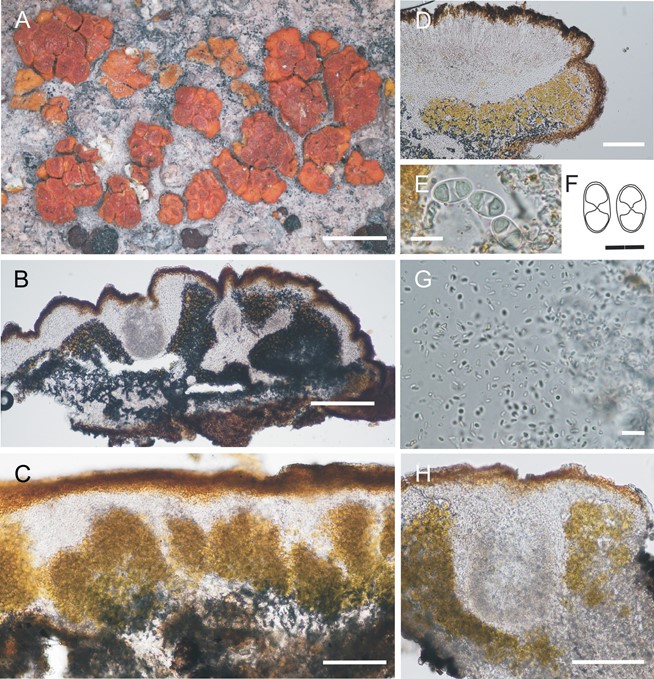Aridoplaca peltata Wilk & Lücking, sp. nov. FIG. 4
MycoBank number: MB 836183; Index Fungorum number: IF 836183; Facesoffungi number: FoF;
Typification: PERU. DEPT. AREQUIPA: Prov. Caylloma, Valle del Colca Valley, near Achoma Village, 15°39′26″S, 71°43′38″W, 3500 m, open, semide- sert montane area, 2 Jul 2006, Flakus 9275 and Cykowska (holotype KRAM-L-71756).
Diagnosis: Thallus saxicolous, squamulose-peltate, orange red. Apothecia abundant, crowded, erumpent, disc red, contrasting against the thallus. Thalline cortex, parathecium, and hypothecium paraplectenchymatous. Ascospores polarilocular, ellipsoid, medium-sized, with medium-thick septa, 12.8 × 7.3 μm, septum 3.9 μm. Pycnidia abundant, completely immersed.
Etymology: The epithet refers to the growth form of the lichen thallus, which consists of peltate squamules.
Thallus 450‒500 µm thick, consisting of peltate squamules, usually confluent and ±orbicular in outline, 1.5‒ 4.0 mm wide, with margins crenate, downturned, orange red, K+ purple, epruinose, with indistinct pseudocyphellae; vegetative propagules absent; prothallus absent; cortex very thick, 35‒170 µm, paraplectenchymatous, uneven, wavy, distinct cortex cones present, necral layer present, 5‒15 µm thick, anthraquinone pigments present; algal layer discontinuous, algae in distinct groups; photobiont trebouxioid, cell globose, 5‒17 µm diam.
Apothecia abundant, crowded, round or angular by compression, initially immersed, then erumpent, zeorine, 0.2‒0.8 mm wide; disc first concave, then plane, red, K+ purple, slightly contrasting against thallus, epruinose, slightly cracked; apothecial margin thin, slightly prominent in young apothecia, then level with disc, slightly paler than disc, epruinose; both margins almost not distinguishable superficially. Parathecium thin, 50‒ 85 µm, paraplectenchymatous, anthraquinone pigments present; amphithecium thin or thick, 70‒200 µm, algae abundant, forming continuous layer or in groups, cortex 15‒35 µm thick, paraplectenchymatous, anthraquinone pigments present; epihymenium reddish yellow, granular (anthraquinones), K+ purple; hymenium 95‒100 µm thick; hypothecium 170‒280 µm thick, paraplectenchymatous, hyaline, oil droplets may be present and then hypothecium obscured by them, stipe absent; para- physes simple to slightly branched apically, 2 µm broad at base, with upper cell 2‒4(‒5) µm wide, oil droplets present; asci 8-spored; ascospores hyaline, polarilocular, ellipsoid to widely ellipsoid, thin-walled, (10.0‒)12.8 ± 1.0 (‒15.0) × (6.0‒)7.3 ± 0.7(–9.0) μm, length/width ratio ca. 1.8, ascospore septa (3.0‒)3.9 ± 0.6(‒5.0) μm, length/septa width ratio ca. 3.5 (n = 40). Pycnidia abundant, ostiole totally immersed, conidia ovoid or bacilliform, 2‒4 × 1 µm.
Habitat and distribution: Aridoplaca peltata grows in semidesert Andean regions, on siliceous rocks, in well-lit conditions, at an altitude of about 3500‒4000 m. Known from Bolivia and Peru.
Paratypes: BOLIVIA. DEPT. POTOSI: Prov. Nor Lipez, near Volcan Ollagüe, 21°17′13″S, 68°05′32″W, 4095 m, open, semidesert high Andean area, 5 Dec 2009, Flakus 14732 & Rodriguez (KRAM, LPB); Pinturas Rupestres near Mallku Villamar Village, 21°46′ 20″S, 67°29′05″W, 4038 m, open, semidesert high Andean area, 6 Dec 2009, Flakus 14773, 14785 & Rodriguez (KRAM, LPB). PERU. DEPT. AREQUIPA: Prov. Caylloma, Valle del Colca Valley, near Achoma Village, 15°39′26″S, 71°43′38″W, 3500 m, open, semidesert montane area, 2 Jul 2006, Flakus 9273 & Cykowska (B).
Remarks: The species is characterized by an orangered, squamulose-peltate thallus and red, crowded apothecia ±immersed in the thallus. The thalline cortex, parathecium, and hypothecium are paraplectenchymatous. The algal layer is discontinuous, consisting of dis- tinct groups of algae. The ascospores are ellipsoid, medium-sized with medium-thick septa. Pycnidia are abundant and completely immersed.
Aridoplaca peltata has an unusual growth form. It shows similarities to another distinctive taxon, Xanthopeltis rupicola. The new species differs from X. rupicola in having a smaller thallus, consisting of peltate squamules forming small rosettes (X. rupicola is monofolious), and polarilocular, straight, ellipsoid ascos- pores (X. rupicola has 1-septate, spirally bent ascospores) (Santesson 1949; Kärnefelt 1989; Arup et al. 2013a). Both species are unrelated, since X. rupicola is nested within Xanthorioideae, closely related to the genus Teuvoahtiana (Kondratyuk et al. 2017) (FIG. 1). The thallus morphology of A. peltata is also similar to that of Caloplaca peltata Räsänen, which should not be confused with the new taxon given the same epithet. The latter differs in having pruinose, flat to slightly concave squamules with slightly upturned margins, which makes it more similar to Psora decipiens (Hedw.) Hoffm. Also, the apothecia are different, growing sessile and usually solitary on the single squamules. Caloplaca peltata is only known from Kazakhstan (Räsänen 1938; Kondratyuk et al. 2004). We found Peruvian material labeled “Caloplaca peltata Merrill.” in F (C1025957F), an unpublished herbarium name, but the specimen represents Xanthomendoza men- dozae (Räs.) S.Y. Kondr. & Kärnefelt.

Figure 1. Teloschistaceae phylogeny. Topology derived from RAxML analysis performed on a combined ITS, 28S, and mtSSU super- matrix for 169 terminals. Amandinea punctata was used to root the tree. The two support values associated with branches indicate Bayesian posterior probabilities estimated with MrBayes and maximum likelihood bootstrap values from RAxML. Only posterior probabilities ≥0.95 or bootstrap values ≥70% are indicated. Thickened branches denote significant support both for posterior probabilities (≥0.95) and bootstrap values (≥70%). Black arrows indicate newly obtained sequences.

Figure 4. Aridoplaca peltata. A. Habit of thallus (Flakus 9275, holotype). B. Cross-section of thallus and pycnidia (Flakus 14785, paratype). C. Cross-section of thallus showing columnar arranges of algae (Flakus 9275, holotype). D. Cross-section of apothecium (Flakus 14785, paratype). E, F. Ascospores (Flakus 9275, holotype). G. Pycnospores (Flakus 14785, paratype). H. Cross-section of pycnidium (Flakus 14732, paratype). All cited specimens were included in molecular analyses. Bars: A = 2 mm; B, C, D, H = 100 µm; E, F, G = 10 µm.
